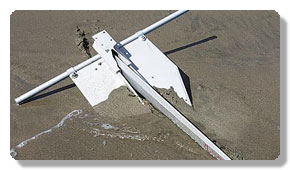Anchor First, Ask Questions Later!
An article by Captain Kent Dresser, Confident Captain/Ocean Pros
When a vessel becomes disabled, a prudent skipper’s thoughts will turn to getting the vessel anchored quickly. Getting the anchor down and set is the first step towards stabilizing the situation and is your first line of defense from ending up on a lee shore. Even if there is enough sea-room to drift for a period of time, anchoring your disabled vessel is always a smart thing to do. You can always weigh your options later. Anchoring allows you to have a stable platform to troubleshoot, remain in a constant position to facilitate those coming to your assistance in locating you, and it prevents your vessel from drifting into an even larger problem. If you are disabled in a busy channel or shipping lane and there is adequate water depth outside of the channel it is reasonable to allow yourself to drift to a safer area, but aside from such special situations, getting the anchor down when you are disabled should be a priority!
Anchoring Tips
Quick Anchoring Can Mean the Difference Between Trouble and Disaster
One of the most important steps a prudent mariner can take in the event of a general problem or an emergency is to anchor his vessel. Anchoring provides a stable vessel and a fixed position, both of which are a tremendous asset when trouble hits while underway.
In most situations when you call Safe/Sea for assistance, the Safe/Sea Dispatcher will ask you to anchor your vessel. This request is not just to promote good seamanship; it could keep you out of a lot of trouble! Setting that anchor could be the only thing that keeps you and your boat from drifting onto the beach or up onto the rocks!! Imagine you are cruising a few hundred yards south of Warwick Light on a nice summer day, when suddenly, your engines stop and you have no means of maneuvering the boat.
With the prevailing southerly winds your vessel has no place to drift but right up onto the rocks scattered along the southern end of Warwick Neck. If you were to add a flood tide to this situation, it would only be a matter of a few minutes before your vessel drifted from safe water to being washed up onto the shore. If you anchor your vessel immediately upon breaking down, your chances of the situation becoming much worse are significantly less. If you wait to anchor your vessel while you are trying to restart, troubleshooting in the bilge, then calling Safe/Sea, you could easily find yourself either dangerously close to, or clearly in, a disaster situation.
There are a number of important steps to remember when anchoring. These steps apply not only in emergencies, but when just anchoring in your favorite harbor.
Ensure that the anchor you have on board is of sufficient size for your boat. The manual or packaging material your anchor comes in will provide general guidelines for the holding capacity of the anchor.
Unless it is absolutely necessary, do not anchor in a shipping lane as you may find yourself in the way of a large ship and not able to move. Also, watch for cable crossings or underwater obstructions. Anchoring on such could damage the underwater structure and make it impossible to retrieve your anchor.
Keep your anchor stowed properly with the rode (line) free of kinks and tangles, but don’t stow the anchor so well that you cannot deploy it in a timely manner. Always make sure that the end of the anchor rode is attached to your vessel. If the rode is not attached, and you lose control of the anchor, than the anchor, the chain, and all the rode will just fall overboard leaving you with nothing.
Make sure you have sufficient anchor rode on board for the depths of water you might be anchoring in. Remember the general guideline for the amount of scope (anchor rode from the bow of your boat to the anchor when in use) to deploy when anchoring if five to seven times the depth of water you are in. This means if you are in twenty feet of water than the minimum amount of scope you want to deploy is one hundred to one hundred-forty feet. You can put even more scope out if you wish. Remember, the more scope you have out on your anchor the better the shock resistance is between your boat and your anchor and, therefore, the better your anchor will hold!!
Once you have deployed the anchor and a sufficient amount of scope, watch to see that the anchor has set (caught) on the bottom. Some tell tail signs of your anchor being set are that there is a significant amount of tension on the rode and it is leading relatively straight out in front of your boat, your bow has turned into the wind, and fixed points on shore are holding a steady range and bearing. If these signs are not present, try increasing your scope by letting out more anchor rode. If you have a considerable amount of scope out and the anchor still does not set, you may want to retrieve the anchor, make sure it has not become fouled in some debris that could prevent it from working properly, and re-deploy the anchor.
In any sort of trouble, your anchor is your best friend. The small amount of effort that it takes to deploy and retrieve your anchor can easily be justified by the amount of trouble you can stay out of with your vessel safely anchored.

